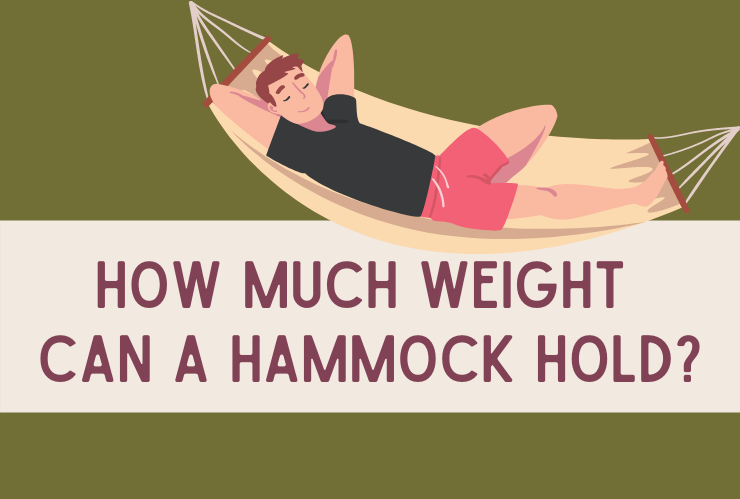There are many good reasons to wonder how much weight a hammock can hold; maybe you’re a bigger guy, perhaps you wanted to get your whole family on for a picture, or maybe you were just curious. Reasons aside, It is always good to know the important safety information concerning the products you own including your hammock!
The amount of weight a hammock can hold all depends on the hammock, suspension, and anchor; however, most hammocks will hold from 300-450 pounds safely. This weight limit is not true for all hammocks so it is important to check the manufacturer’s rating. I have an ultralight hammock that is rated to 250 pounds but most of my hammocks are rated up to 400.
Contents
Should You Follow the Manufacturer’s Rating?
This is always a hot topic online. Most manufacturers set a weight limit for their hammocks. This information can most often be found on their website, sales page, packaging, or tags on the hammock. The weight limit is created in order to protect the company from liability; it also provides customers with useful information so they can be more satisfied with their purchase.
Because it is important for a company to be able to guarantee that their hammock will not fail under a set amount of weight they will often set the limit a little bit lower than what they actually believe is the maximum weight the hammock can hold.
Does this mean that you should put more weight in a hammock than the manufacturer’s rating recommends? No, that would not be a good idea for multiple reasons. For one, you could break your hammock and not be entitled to a refund which most good manufacturers often do. Another good reason is for your safety; you wouldn’t want to hurt yourself because you ignored the weight limit.

Weight for Camping Hammocks
When it comes to finding a long lasting camping hammock, you should avoid cheap brands regardless of their weight limits. Brands like Hennessy and Kammok(there are many more but that’s not the point of this article) use quality material and stitching that result in a higher quality hammock.
Cheap no name hammocks often rip or tear after frequent use while a nice one may last for years and years. Some great hammock brands are not even that much more expensive than the cheap ones. The Hennessy Hammock that I use and have recommended has a 300-pound weight rating.
Quality parachute and camping hammocks made of nylon or polyester can usually hold around 400 pounds but make sure to check for each specific product. As I mentioned earlier, you may see hammocks advertised with a 600-pound weight limit for sale at a price of around $25 but you usually end up getting what you paid for.
One other thing to note is that there are also camping hammocks that are designed for two people. Although you might think that because they were designed with the weight of two people in mind that they must have doubled the maximum weight limit, this would be wrong.
Most two-person hammocks have the same, or only a slightly increased weight limit, compared to their single person equivalent. Make sure you take this into account before putting two people in any hammock.
Permanent Hammocks and Weight
There are some major differences between portable camping hammocks and permanent setups. For one, I’ve recommended screwing hooks into trees to benefit their long-term health if you can’t use a stand. One thing that is fairly consistent between the two is weight limits. With permanent setups, you still have to take into account the weight limit of your anchor but the hammocks are usually rated for around the same amount of weight.
When it comes to permanent hammocks there are more of a variety and less trusted brands to choose from. The hammocks that I looked at are all rated for around 400 pounds. This is true for the thicker polyester ones, nylon hammocks, and even rope hammocks.
Again, you should not take my word in case it doesn’t apply to your specific brand and model. You should take the time to be aware of that information by looking at your packaging or the manufacturer’s website.
Hammock Chair Weight Limits
One type of hammock that holds a vastly different amount of weight is the hammock chair. The big difference between hammock chairs and traditional hammocks is that with the chair there is usually only one anchor point which is normally located directly above the setup. Another thing you may notice about hammock chairs is that the chair itself is often much bulkier and heavier than a normal hammock.
Most hammock chairs are only rated to hold around 250 pounds compared to the 400 pounds of a regular hammock. Because the single anchor point is often a hook drilled into the underside of a branch I recommend more frequent inspections of the anchor and stress points.

Using a Hammock Stand
In the past I have recommended using stands when it comes to helping the environment but how are they when it comes to holding weight? Well, as with everything it depends. I found hammock stands with a variety of different weight limits and what you choose could be the difference in the total overall weight capacity of your hammock. One thing to keep in mind is that your hammock’s weight needs to be included in the maximum capacity of the stand.
When looking into stands I found quality ones that held 400 pounds, I also found other quality ones that held 220 pounds. When shopping for a hammock and stand, finding a stand that will hold more than you need is a top priority.
After choosing a stand you can then buy a hammock knowing how much you will be able to hold in total. You wouldn’t want a hammock that holds 450 pounds to be limited by a stand that can only hold 220 pounds.
Permanent Anchor Points
Anchor points refer to the spots in which the hammock connects to the actual anchor which is usually a stand or trees. In most cases, the anchor points are hooks drilled into a tree, straps wrapped around the tree, or the connection rings on your hammock stand. I already talked about stands but how much can other setups hold?
The hardware for permanent hammock setups can be found in kits located in many department stores and online. These kits are already marketed to hammock users. You can buy all the pieces separately at a hardware store as well; most people online seem to use 3/8″ eye bolts. If you are unsure of what can hold your weight it may be a good idea to buy the kit.
If you do get a kit and install it properly, your anchors should be able to hold well beyond the amount that your hammock can hold. Just remember that the tighter your hammock is, the more stress it is putting on the hardware. Remember to check your hardware frequently so you can tell if anything is wrong.
Hammock Straps and Suspension
Hammock strap suspension systems are similar to stands in that some are rated to hold more weight than others. For example, the MalloMe Tree Straps are rated to hold 2000 pounds, while the Eno Atlus is only rated for 400 pounds. Even though there is such a difference in rating, both of these suspension systems are excellent options.
If you decide to use homemade straps make sure that you know how much weight the material you are using can hold. If using rope or webbing this information should be easy to find. I do not recommend using a rope as it can damage trees. I suggest using tree friendly straps.
Carabiners
Carabiners are another very important piece of hammock equipment that must be able to support a substantial amount of weight. I highly recommend that you inspect EVERY carabiner that you get for quality. If it says “Not for Climbing”, or something similar, then do not use it for your hammock.
There are other things you should look for such as it being made of solid metal, any damages or cuts, and how sturdy the gate is.
One of the biggest problems with cheap hammocks is the carabiners. Using some of these cheap low-quality products could cause your hammock to collapse and result in someone being seriously hurt. Please do not use any carabiner that is not intended to hold a person’s weight in the suspension system of your hammock.
Anchors
It should go without saying but make sure that you inspect your anchors before setting up your hammock. If you are using trees you should make sure they are at least six inches in diameter. You should also make sure the tree isn’t rotten. If the trees themselves begin to sag then please relocate your hammock.
One of the worst things that you can anchor your hammock to is drywall. If you are going for a permanent setup inside of your house make sure you are connecting to studs on each side of the hammock. This can be really inconvenient but drywall is not strong enough to hold most people’s weight. If you really must have your hammock in a certain spot then perhaps a stand will work better
Three-Point Hammocks

In this article, I did not take a look at three-point hammocks. These are becoming more popular every season. Tentsile, one of the few large reputable manufacturers of three-point hammocks offer MANY different models, with many different weight restrictions.
There is even a three-person model that can hold over 800 pounds! I hope to take a look more into everything about three point hammocks in the near future.
So What?
In this post, I have looked at a number of different methods that you can use to suspend your hammock. I have also raised a number of different considerations that you should take into account when selecting different aspects of your set up including the hammock itself, the suspension, and the anchor.
I hope that you now feel more confident in understanding hammock weight restrictions and are confident in setting up a hammock for your needs!
References:


